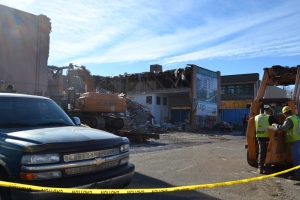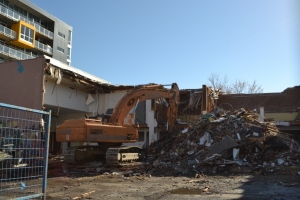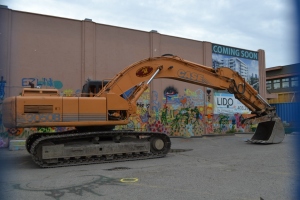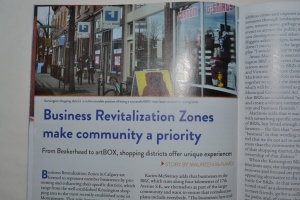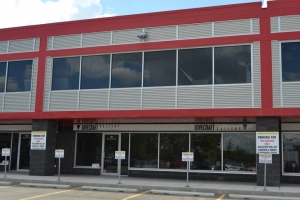
Last month a new gallery space opened. This in itself is not all that newsworthy, but still worthy of mention nonetheless. This one was interesting only because of how it opened, its location, and the perceived focus of the space.
The gallery?
LoveCraft Gallery.
This all crossed my radar screen before it opened, most likely around the time it launched its fundraising campaign on Kickstarter. This campaign was intended to help with start-up costs and to facilitate fixturing of the company’s newly occupied space, in a newly built building.
I will get back to LoveCraft Gallery later (once I got there I realized it will be in a new article because of the length), as what I want to write about is not entirely about them. Their opening did however provide the motivation to write about something larger that I have been intending to write about for quite some time – craft.
* * *
During the past five to ten years – and maybe it is just me – there seems to be an increased awareness of craft in the city. Craft has been an integral part of the curriculum at the Alberta College of Art and Design since it opened for full-time instruction in 1927 while it was still a department at the old Provincial Institute of Technology and Art – now more commonly known as SAIT Polytechnic.
When we look back the Alberta College of Art and Design has consistently had a lot of strength in their craft-based programs. This is no doubt partly a result of having great early departmental chairs and instructors in the ceramics program who helped set it up for success – people like Luke Lindoe, Marion Nicoll, Katie Ohe and Walt Drohan. It was also a similar situation in the glass program which Norm Faulkner started at ACAD during the 1970s and this very stable ground has enabled the program there to be recognized as one of the best in Canada. I could continue with the fibre program, jewelry and others. Needless to say ACAD in particular has been very important in this whole area of craft in Calgary and area. Other institutions have played a role in city, but certainly not to the same extent.
We can see here that craft as an artform has deep roots in the city, going back entire careers for some that are now retired and in other cases even deceased. Some of these significant craft-based initiatives in the past, in no particular order are:
- The magazine Artichoke which was active in (if memory serves me correct) the 1980s to 2000s period. It was primarily focused on fine art, but regularly celebrated craft in an art context.
- During the 1988 Olympics, the Petro-Canada Art Gallery (yes, there was a corporate art gallery with scheduled exhibitions and curatorial staff in what is now called Suncor Plaza) in conjunction with the Olympic Arts Festival hosted an exhibition entitled Restless Legacies: Contemporary Craft Practice in Canada with a 100-page catalogue containing annotated essays and colour illustrations.
- At one time there was a very serious attempt to create a public gallery focused on craft in the city that came very close to happening (something I am sure I will talk about in a different setting at some point in the future).
- The Triangle Gallery (later MOCA Calgary and now Contemporary Calgary – or more specifically C2) often would show craft especially during the directorship of Jacek Malec.
- For a very long time (probably 30 years or more) there was an artist-run cooperative at the base of the Calgary Tower in Palliser Square that regularly showed ceramics in particular – the Centennial Gallery. Their gallery was visible across the street from the 9th Avenue entrance of the Glenbow Museum. I believe that the cooperative running it closed a number of years ago, probably around the time of the redevelopment of Palliser Square. It was notable for giving some visual artists their first show or sales at emerging stages of their careers, in conjunction with the regularly available craft-based work which was their primary focus. On Edit and Erratum(2014 June 20) I must apologize for this oversight – the Centennial Art Gallery is very much operational and is still located at the base of the Calgary Tower. It appears to have moved locations to a less visible space in Palliser Square during the renovations mentioned above. This is where my comments derived. My apologies. Their address is Suite 153, 115 – 9 Avenue SE and they are open from Monday to Saturday)
- The Calgary Allied Arts Centre housed a large Luke Lindoe ceramic which was commissioned by the Canada Council in celebration of the Centre’s grand opening and resided inside the main lobby along with a large Sèvres Porcelain Vase on loan from a private collection. They also had an active teaching program in craft especially for children during the time it was operational mostly during the 1960s on 9th Avenue SW.
- I would be remiss if I did not mention Audrey Mabee. She along with her business partner Betty Anne Graves during the mid-1970s opened a fine art shop called The Croft. It was located on 8th Street across from Mount Royal Village which focused exclusively on craft-based work, mostly featuring local artists with a focus on hand-crafted ceramics. It was within viewing distance to many of the leading commercial galleries during that period which also were located across from Tomkins Park and Mount Royal Village on 17th Avenue SW. She successfully continued that business until the late 1990s or early 2000s when it was sold to another party. A few years later the premises were expanded while keeping the focus on craft, when the new owners moved the business to the Mission area along 4th Street SW somewhere near 20th Street. I would assume they moved it probably around the time when the character of 17th Avenue as a gallery row had dramatically changed partly due to redevelopment. The Croft has subsequently closed, but was definitely influential in raising awareness of craft in the city. Audrey Mabee later was named an interim president of the Alberta College of Art and Design. She along with her son Rob Mabee started ArtSpace in the Crossroads Market probably a year or two after she sold The Croft. There were a number of independent small boutiques and galleries in ArtSpace, a number of which featured craft-based work as well. Around the time that the ascendancy of ArtSpace had passed, Rob Mabee moved on to Art Central working initially as the leasing manager charged with filling the newly-restored building. Around that same time Audrey opened a small studio for a few years and in time Rob opened Axis Gallery which focused on contemporary art. The gallery also would periodically show some craft, notably Bee Kingdom and a ceramist who created small human figures.
- Talking about 17th Avenue and commercial galleries, there also was a small house that operated as a gallery on the other end of the strip from The Croft for about five years called Gallery San Chun. The couple who owned it were recent immigrants from Korea. She was a printmaker. They were a lovely couple. I believe her name was Mee and I forget his. They would often show ceramics and other craft-based work from Korea where there is a proud tradition of craft as art in conjunction with printmaking. They were very supportive of the local community and often would give recent graduates in printmaking their first commercial show. They in turn moved to the Lower BC Mainland when they closed the gallery around the same time as the character of 17th Avenue had changed for galleries. A couple years later in Art Central another Korean lady (I should know it, but forget her name) operated a small little shop called The Korean Gallery. She also had training in Korea and she brought in outstanding Korean ceramics. She also featured a young artist Diana Un-Jin Cho whose work referenced traditional fibre art from Korea. I championed her work, even though I never dealt with her, and was responsible for placing a large piece of hers into the Civic Art Collection.
- A commercial gallery and bookstore called the Guild Gallery of Artists and Authors operated by a single dentist, Dr. Max Lipkind, who recently passed away and his long-time assistant. It was located on the main floor of what is now the downtown campus of the University of Calgary. It regularly featured ceramics and if I remember correctly glass as well. These craft-based works were shown in the context of an amazing and eccentric mix of artworks ranging from Joan Miró and Pablo Picasso graphics, to Elke Sommer paintings, to works by Jean-Paul Riopelle. He had a most interesting and wide selection of art with a focus on international graphics and mid-century art if I remember correctly. Much of the art and artists he handled I have long-ago forgotten. It was a gallery that was unlike any other gallery in the city. He needs to be mentioned, even though his gallery certainly was not highly influential in the traditional sense. He and his assistant both had a common man’s touch and made the work that they presented, accessible. In some odd and unusual ways, I probably could credit him and his gallery at least to an extent for introducing me to art in a professional setting, while I was still a young teenager. He would always find time to say hi and answer questions whenever I would stop in to look at and purchase comic books and make the visit to the gallery portion of his shop.
- Art Central also housed a significant number of small businesses that presented craft. In some ways this was Art Central’s legacy. The size of the shops lent themselves more to smaller works and the lack of storage space in the building, meant most of the inventory had to be on display. It was probably for this reason a number of craft producers and businesses used the space as a retail or business incubator. There were many shops that showed craft,
- some of which are still operational (such as Influx Gallery and depending on how one defines craft it could even include Studio Intent and others dealing primarily in fashion); and
- others which are not operational (such as Dashwood Galleries, Collage Gallery, If Looks Could Kill Art Studio, Glass Cube Contemporary Art Space, The Korean Gallery, Interiors in Balance and Nova Scotia Crystal); and
- there are also others whose current status is uncertain (such as Rox Gems and UP Studio).
- Of course, it goes without saying that I am certain there are many others whom I have forgotten, and from those that I have mentioned many have moved on to other projects and quite possibly are still producing.
- I am sure that I could continue with many, many more examples.
Because of all these things, it is not surprising that there is an awareness of craft in the city. There is a great tradition here.
* * *
This leads us to the present day. What is happening right now as I write this?
There still is a large selection of opportunities to purchase, exhibit or sell craft-based work. A number of art galleries have shown the willingness to crossover, and as seen in this article, craft-based work and ceramics in particular are noticeably present at the current iteration of the international art fair, Art Basel which opened within the last day or two.
Currently the Esker Gallery in its Project Room is featuring Yvonne Mullock. I am a big fan of hers and I find that she is doing some quite interesting things. I note with interest that the Art Gallery of Alberta earlier today announced a listing of 42 artists for the 2015 Alberta Biennial and see that her name is on this list. So therefore congratulations are in order. Getting back to the Esker Project Room, I had the dubious honour of being the “first male hooker” in her current project (or maybe there is no honour involved, because my wee contribution is probably the worst crafted part of the whole hooked rug, and as a result it is just dubiousness instead). Here she is working in conjunction with members of the Chinook Guild of Fibre Arts and guests who like myself may take a stab at hooking an enormous (30” x 120”) hooked rug. This work entitled Hit and Miss which they are currently working on is a large rug that will eventually be located at the front door to the Esker Foundation. A photo (see below) that I appropriated from Yvonne’s facebook page earlier today shows it in a state of partial or near completion.
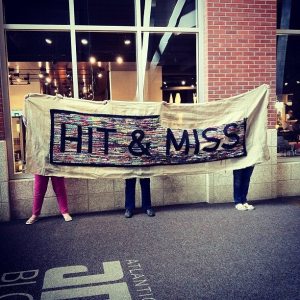
Also on exhibit at the Glenbow is a mini-retrospective of the Bee Kingdom group of glass artists curated by Mary-Beth Laviolette. It was a good choice on the Glenbow’s part in selecting the curator, as Mary-Beth has had a long interest in craft-based work. I also have a significant interest in this group as I proposed a successful acquisition of five pieces from the collective (one piece from each individual and a collaborative Mythopoet work) for the Civic Art Collection Committee when I was the Chair of that committee. I hear through the grapevine that one of their Mythopoet pieces from that acquisition, is currently residing in the office of the Mayor. There is an interesting backstory to this work as the Mayor was in the Bee Kingdom Studio when this work was being produced. I have forgotten the specific details, but I am sure that if someone was to ask, Mayor Nenshi would be able to complete the story and the circumstances why he was there.
As for the Glenbow show, if I was to express a criticism, it would be that there was no mention of the fourth member of the Bee Kingdom collective – Kai Georg Scholefield. Although he was only a member for a couple years between 2011 and 2013, it is unfortunate that there was no mention of him in the didactic panels or the simple inclusion of one their Mythopoet pieces from that period (the one in the Civic Art Collection would have worked). In my opinion, he did a lot for the group, more than he is probably given credit for including his time as the director of the short-lived Glass Cube Contemporary Art Space that pre-dated his involvement as the fourth member. I am sure that there was a valid reason for this oversight, but it is unfortunate nevertheless. The show is well worth seeing and it is up for the remainder of the summer.
While I am talking about the Bee Kingdom I should also plug another thing that is coming up very soon – in fact later today. It is an artist’s talk that they will be conducting at the Water Centre (625 – 25 Avenue SE) between 7:00 and 9:00pm. This talk is a result of a residency as connected to the UEP (the City of Calgary’s Department of Utilities & Environmental Protection) that that the three Bees (Philip Bandura, Tim Belliveau and Ryan Marsh Fairweather) are currently in the midst of. They spent most of their time connected to a couple water treatment plants. This artist talk is sponsored by WATERSHED+ in cooperation with the Public Art Program. It will be interesting to see and hear what came as a result of this project. I am definitely looking forward to it.
The UEP is amazing for what they are doing with artists and public art. One may recall the summer of 2010 when the UEP sponsored a summer-long public arts festival entitled the Celebration of the Bow River. What was particularly memorable for many was the warm summer evening when giant orbs of light were released from Edworthy Park to float down the river to Prince’s Island Lagoon. It was a magical public art event enjoyed by people of all ages which was created by Laurent Louyer and Creatmosphere. There also was a big launch of 100 small wooden boats containing mud from various parts of the Bow River and were released early one Saturday morning from Fish Creek Park designed to track water currents south and east of the city. This project was coordinated by Peter Von Tiesenhausen. This whole summer of art events won a major award for one of the best public art projects in North America that year. It was a very proud moment for our Public Art Program (and rightfully so). But once again, I digress.
Of course, we read in the articles and watch or listen to the news coverage about the one-year anniversary of last year’s flood which is coming up tomorrow. The almost non-stop rain for the past week or so has only helped feed the news. Just as it was the case last year, Sled Island is gearing up for its annual event. Although Sled Island has always had a focus of some sort on the visual arts, this year they have expanded that even further and have curated programming.
Last year Sled Island teamed up with Etsy and held a juried exhibition was hosted by MOCA Calgary where they featured the work of Bryce Evans in a project called The One Project—an online collaborative project founded by Evans to inspire people out of depression and into their dreams. The work included conceptual, abstract, and experimental subject matter with a focus on driving positive social change in the world.
I attended the opening the night that the flood happened. Since MOCA Calgary was in the flood zone, this show got very little press. This is completely understandable. It is possible that it may have only been available to view for that one night only, because of where MOCA was located and how long that area was evacuated – even though MOCA was not affected. I attended that opening and while there a friend texted me to inform me that my home was in the evacuation zone. I had been at work all day, and went directly to the opening, so was completely oblivious to what was going on outside of work. When I received the news, I had resigned myself to the fact that my home was probably under water – and there was nothing I could do about it – so I drank wine instead. As expected, I received an evacuation order on the way home. It was an interesting show and I had a great conversation with one of the Etsy staffers who flew out from Toronto for the opening. But I digress.
This year, just as was the case last year, Sled Island is teaming up with the Victoria Park BRZ to present another outdoor iteration of PARKSale this weekend in the Haultain Park. Last year this sale was cancelled due to the flood which had the area under water and was rescheduled during mid-August 2013 once the flood waters had subsided and life was starting to return to normal. The photo below is not particularly good, but it is one that I took at that sale. PARKSale is one of the regularly scheduled projects of PARK (Promoting Artists | Redefining Kulture) an organization that has been active as a non-profit organization focused on local artists, presenting sustainable and recycled fashion in a low-impact environment since 2011 (and possibly earlier).

This year as they attempted to do last year, but was cancelled by the flood, Sled Island is also teaming up with East Village and the Hi-Fi Club to present another iteration of Market Collective. This iteration will be a mini-market and take place on the Riverwalk in conjunction with what is advertised as a Sled Island Block Party. Market Collective began in 2008 and of all the pop-up markets it has probably had the most number of locations where it has presented its periodical weekend long events. It is probably also the largest market in terms of vendors. Unfortunately I do not have a photo of the mini-fair as I don’t believe it was rescheduled last year (although it is possible). This event will also take place on the same weekend as the PARKSale. It is possible to make the trek from one venue to the other.
* * *
The above has been an overview of some of the notable organizations that helped set the current craft-based organizations up for success. I also included the current projects that are happening right now, mostly because of timeliness.
I had to break this blog post into two, because otherwise it would be far too confusing. Part two will talk about the various venues, markets and spaces that act as incubators, facilitators and organizational structures for craft in Calgary.
